Science Highlights, January 20, 2016
Awards and Recognition
Earth and Environmental Sciences
Geo-material microfluidics platform studies subsurface reservoir conditions
Intelligence and Space Research
Mars rover confirms evidence of an ancient lake and discovers silica enrichment in rock
Awards and Recognition
Bruce Carlsten named IEEE Fellow
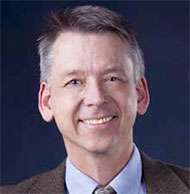
Bruce Carlsten
The Institute of Electrical and Electronics Engineers (IEEE) has honored Bruce Carlsten (Accelerator Operations and Technology, AOT-DO) with the title of Fellow. IEEE cited him “for contributions to high-brightness electron beams and vacuum electron devices.” Carlsten is a pioneer in the production and use of high-brightness electron beams. His discovery of techniques enabling unprecedented beam brightness has led to a new generation of intense free-electron lasers, including the Lab’s Navy Free Electron Laser (FEL), and MaRIE, a proposed premier x-ray FEL facility. These ideas are of such fundamental importance that virtually every free-electron laser in the world uses them.
Carlsten received a PhD in electrical engineering from Stanford University and joined the Lab in 1982. An accelerator physicist and radio frequency (RF) engineer, he is principal investigator for two Laboratory Directed Research and Development (LDRD) projects and a project for the U.S. Department of State developing advanced radar technologies. Carlsten has been technically supporting MaRIE, the Laboratory’s proposed experimental facility for the study of Matter-Radiation Interactions in Extremes, since its start in FY 13. He has served as the Work Package Manager for x-ray FEL and electron beam physics, and leads the development of an integrated numerical modeling tool for MaRIE’s conceptual design. Carlsten serves as a U.S. government advisor for various accelerator and radio frequency technology development programs, including as a member of the joint National Science Foundation/Department of Energy High Energy Physics Advisory Panel and the Advisory Board for an Air Force Office of Scientific Research multidisciplinary research initiative on transformational electromagnetics. He is a member-at-large of the IEEE Particle Accelerator Science and Technology Technical Committee and the American Physical Society’s Executive Committee of the Division of Physics of Beams, and a Fellow of the American Physical Society and Los Alamos National Laboratory. Carlsten has received three Los Alamos Distinguished Performance Awards, a U.S. Particle Accelerator School Prize for Achievement in Accelerator Physics and Technology, and six patents on novel accelerator and RF source technologies. He has more than 100 referred publications and serves on the Editorial Board of Physical Review Special Topics – Accelerators and Beams. Technical contact: Bruce Carlsten
David Morris chosen as AAAS Fellow
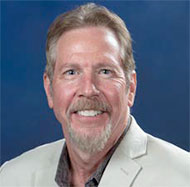
David Morris
The American Association for the Advancement of Science (AAAS) has awarded the distinction of Fellow to Dave Morris (leader of Chemistry Division, C-DO). The AAAS selected him for his pioneering contributions in chemistry research and leadership including electronic structure and bonding in organoactinides and environmental speciation of actinides by optical spectroscopic probes.
Throughout his career, Morris has made unique and significant contributions in two distinctly different areas of chemistry. The first is in the application of spectroscopic and electrochemical methods to explain electronic structure and bonding in organometallic f-element complexes. The second research area is the development and application of electronic and vibrational spectral probes, in combination with x-ray absorption spectroscopies, to explain the partitioning of uranium in clay minerals and other important subsurface mineral phases.
Morris received a PhD in analytical chemistry from North Carolina State University. He joined the Lab as a Director’s Postdoctoral Fellow in Inorganic and Structural Chemistry (INC-4) in 1984, to continue his studies in inorganic photophysics and transient excited-state structure. When Morris became a technical staff member in 1986, he began his career-long research in fundamental and applied actinide science. His research has resulted in more than 100 peer-reviewed publications. Morris has held line and program management roles. Technical contact: David Morris
Sarya Fensin wins TMS Young Leaders International Scholar Award
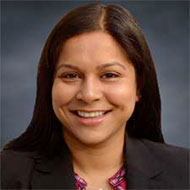
Sarya Fensin
As recipient of the 2015 TMS Young Leaders International Scholar-Japanese Institute of Metals (JIM) Award, Saryu Fensin (Materials Science in Radiation and Dynamics Extremes, MST-8) will represent The Minerals, Metals and Materials Society (TMS) at the JIM Spring Annual Meeting at the Tokyo University of Science in Japan. The award is part of the TMS Young Leaders International Scholar Program, a JIM and TMS exchange program providing young professionals the opportunity to present research at international meetings and network with researchers at laboratories and industrial facilities abroad. The TMS Membership & Student Development Committee selects recipients, and the TMS Foundation funds the award.
Fensin earned a PhD in materials science and engineering from the University of California – Davis and joined LANL as a postdoctoral researcher in 2010. She is a scientist the MST-8 Dynamic and Quasi-static Loading team, where she uses experiments and simulations to examine the relationship between material microstructure and properties in thermodynamic and mechanical extremes. Her tools include molecular dynamics, Monte Carlo methods, gas gun experiments, metallography, and various microscopy techniques. She studies the behavior of material microstructure and the role of second phase particles – single and bi-metal interfaces – on damage nucleation and evolution under dynamic loading conditions, as well as aging affects in plutonium. Fensin holds leadership roles on the TMS Young Professionals, Professional Development, Diversity, and Mechanical Behavior of Materials committees. She previously won a TMS Young Leaders Professional Development Award in the Electronic, Magnetic & Photonic Materials Division. Technical contact: Saryu Fensin
Sandra One Feather honored as AISES Sequoyah Fellow
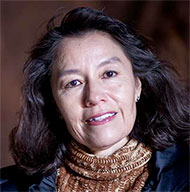
Sandra One Feather
The American Indian Science and Engineering Society (AISES) has chosen Sandra One Feather (Office of Talent Management, HR-OTM) to be a Sequoyah Fellow. AISES recognizes Sequoyah Fellows for their commitment to mission in science, technology, engineering and math (STEM) and to the American Indian community. Sequoyah Fellows engage in leadership, mentorship, and other acts of service that support students and professionals in the AISES family. One Feather conducts presentations at national AISES conferences and assists in recruiting students at Laboratory career fairs.
One Feather received a BS in business administration from Fort Lewis College, a BA in journalism from the University of Minnesota, and a MBA from Northern Arizona University. She joined the Laboratory 12 years ago. One Feather currently works with the HR-OTM team to develop and implement an institutional knowledge transfer initiative in 2016.
The mission of the American Indian Science and Engineering Society is to substantially increase the representation of American Indians, Alaska Natives, Native Hawaiians, First Nations and other indigenous peoples of North America in science, technology, engineering and math studies and careers. Founded in 1977, AISES has a membership of more than 3,500 individual members. The society sustains 186 chartered college and university chapters, 14 professional chapters, and 170 affiliated K-12 schools supporting American Indian students in the critically needed STEM disciplines. The society named the Fellows program in memory of Sequoyah, the great Cherokee Indian who perfected the Cherokee alphabet and syllabary in 1821, resulting in the Cherokee Nation becoming literate in less than one year. Technical contact: Sandra One Feather
Nan Sauer receives Outstanding Alumna Award from Iowa State University
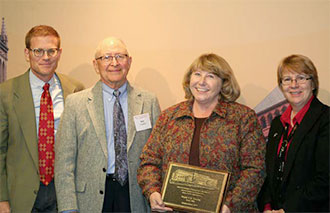
Photo. (Left to right): William Jenks, Chair, Department of Chemistry; Bob Angelici, Distinguished Professor Emeritus, Department of Chemistry (and Sauer’s advisor at Iowa State University); Nancy Sauer; Beate Schmittmann, Dean of the College of Liberal Arts and Sciences. Jenks nominated Sauer for this honor.
The Iowa State University Department of Chemistry presented Nan Sauer (Associate Director for Chemistry, Life, and Earth Sciences, ADCLES) with an Outstanding Chemistry Alumna Award during the Liberal Arts and Sciences Honors and Awards Ceremony in Ames, IA. The award recognizes outstanding alumni and friends of the Department of Chemistry and College of Liberal Arts and Sciences.
Sauer received a PhD in inorganic chemistry from Iowa State University and joined the Lab as a Postdoctoral Fellow in 1987. She has held a number of technical and programmatic leadership roles for the Laboratory, including being the first director of the LANL Institutes office. Sauer has received a Defense Programs Award of Excellence, a R&D 100 Award, two LANL Distinguished Performance Awards, and the Fellows Prize for Leadership. Technical contact: Nan Sauer
Earth and Environmental Sciences
Geo-material microfluidics platform studies subsurface reservoir conditions
As the population increases, the demand for global energy continues to increase. By 2030, the demand for all energy types (nuclear, renewable, natural gas, coal, and oil) is expected to more than double. This increasing demand for energy around the globe requires a better understanding of subsurface energy resources and their associated environmental issues. In the U.S. alone, the subsurface currently provides more than 80% of total energy needs. Los Alamos researchers have developed a high pressure and temperature microfluidic experimental system to investigate pore-scale fluid flow and transport within geo-materials encountered in subsurface energy resource applications. The information gained from this platform could enable development of future subsurface energy resource technologies while understanding and mitigating the environmental consequences. The journal Lab on a Chip published the research.
Although subsurface energy operations are often viewed as reservoir-scale problems (ranging from tens to hundreds of kilometers), the underlying fluid flow and transport processes occur within the rock’s nano- to millimeter-sized pores and fractures. Technology aimed at controlling fluid flow (e.g., water, brine, oil, and gas) within the rock’s micropores and fractures underlies all subsurface energy applications. A few examples of these applications include: 1) the production of fossils fuels, which is essentially a multi-phase fluids problem between oil, gas, and brine; 2) enhanced oil recovery, hydraulic fracturing, and geothermal operations, which rely upon fluid flow and transport technologies; and 3) storage and disposal solutions for energy, energy wastes, and environmental impact mitigation (i.e. carbon sequestration). Investigations of flow and transport in subsurface porous and fractured media could play a significant role in the development of these ongoing and future subsurface energy resource technologies. However, the majority of experimental systems to date are limited in applicability due to unrealistic operating conditions, the use of engineered material micromodels, and the lack of realistic pore or fracture geometries.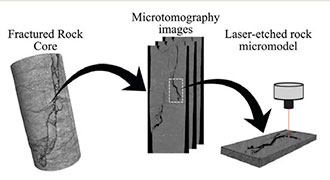
Figure 1. Illustration of the procedure to etch realistic fracture patterns in rock micromodel substrates .
Mark Porter (Earth System Observations, EES-14) led a team of Laboratory researchers to create a high pressure and temperature microfluidic experimental system for direct observations of flow and transport within geo-material micromodels (e.g. rock, cement) at reservoir conditions. This system can examine the fluid flow and transport processes that occur within rocks at the micron to millimeter-size pores and fractures. These micro-scale investigations provide real-time, pore-scale quantification of fluid, interfacial, and mass transfer dynamics, making it possible to characterize and eventually optimize fluid flow in fractures and porous media.
The investigators developed a novel micromodel fabrication method that works in both geo- and engineered materials and utilizes 3-D tomography images of real fractures as micromodel templates to better represent the pore space and fracture geometries expected in subsurface formations. The team created micromodels by cutting and mounting thin sections that were cut from larger rock cores. A laser system designed and constructed at the Lab’s Center for Integrated Nanotechnologies (CINT) etched features down to 10 μm. The researchers used 3-D microtomography images from a triaxial coreflood, shear fracture experiment to generate real, complex pore or fracture patterns. After loading the micromodels into the pressure vessel, the team conduced experiments using brine, oil, and carbon dioxide (CO2) at temperatures and pressures similar to naturally occurring reservoirs.
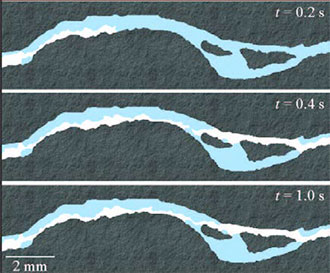
Figure 2. Time-lapse images of scCO2 displacing water in a fracture etched into a shale micromodel. The white, blue, and gray colors represent scCO2, water, and shale , respectively.
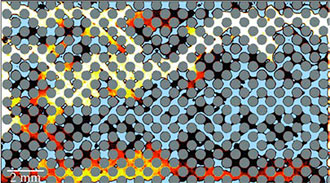
Figure 3. Supercritical CO2 (white) displacing n-decane (black) and brine (blue) at a time step of 280 seconds . The gray circles are the solid phase . The color gradient from yellow (high) to red (low) represents the concentration of scCO2 in oil. The image is 1109 x 618 pixels with a resolution of 16 μ m per pixel. Scale bar indicates 2 mm.
Characterization of supercritical CO2 (scCO2) displacing water in fracture networks is critical for predicting the performance of CO2 sequestration within a given rock. Experimental results show that injected supercritical CO2 quickly creates a narrow path within a fracture and continues along that path, leaving a significant amount of water in the fracture. Fracture surface roughness likely causes the localized displacement path. This experiment demonstrates the complexity of immiscible displacement in realistic rock fractures. The displacement efficiency is greatly reduced in this fracture compared with that observed in straight fractures. This result illustrates the need for experimental platforms using more realistic representations of rock geometries and properties to obtain microfluidic data for model verification.
The team conducted additional experiments to model scCO2 injection, which has been proposed as an alternative fluid for hydraulic fracturing (Figure 3). As scCO2 migrates through the pore space, it displaces brine and oil. As brine is removed, scCO2 comes into contact with disconnected blobs of oil, dissolving into and modifying the oil’s rheological properties, which leads to additional oil recovery over time. This illustrates the coupling between multiphase flow (oil–brine and scCO2–brine) and fluid mixing from viscous fingering (oil–scCO2). Using scCO2 in the experiments provides advantages because the CO2 fluid properties and its interaction (i.e., mixing) with oil are highly dependent upon pressure and temperature. The new platform enables experiments at various pressure and temperature conditions, allowing the team to investigate the transition from immiscible to miscible oil displacement using CO2 and cyclic gas injection scenarios that mimic field scale operations.
The experimental platform uses a unique micromodel fabrication method that works with several different rock types and engineered materials. This provides flexibility in the types of experiments that can be conducted and allows comparison of experiments in engineered material with those conducted in geo-material. The data also enable benchmarking of pore-scale numerical models. These microfluidic experiments represent a significant step towards assessing actual pore-scale flow and transport processes within real rocks at reservoir pressures and temperatures, resulting in improved constitutive relationships and conceptual models for reservoir-scale operations. This information is critical for understanding subsurface environments and their subsequent energy applications, such as conventional and unconventional oil and gas development, enhanced oil recovery, geothermal energy, CO2 sequestration, and nuclear waste repositories.
Reference: “Geo-material Microfluidics at Reservoir Conditions for Subsurface Energy Resource Applications,” Lab Chip 15, 4044 (2015); doi: 10.1039/c5lc00704f. Authors: M. L. Porter, J. Jiménez-Martinez, and J. W. Carey (Earth System Observations, EES-14); H. S. Viswanathan (Subsurface Flow and Transport, EES-16); and R. Martinez and Q. McCulloch (Center for Integrated Nanotechnologies, MPA-CINT).
DOE Fossil Energy and the Laboratory Directed Research and Development (LDRD) program funded different aspects of the work. The DOE Office of Science funds the Center for Integrated Nanotechnologies (CINT). Apache Corporation provided in-kind services. The research supports the Lab’s Energy Security mission area and the Materials for the Future and Science of Signatures science pillars. Technical contact: Mark Porter
Intelligence and Space Research
Mars rover confirms evidence of an ancient lake and discovers silica enrichment in rock

Photo. Southward-dipping sandstone rock facies typical of the foreset beds observed over 9 kilometers in Gale crater.
A paper in the journal Science reported on findings compiled from various points along the Curiosity rover mission through Gale crater on Mars. The results indicate the duration and extent of open water in the early Hesperian period approximately 3.6 billion years ago. Over a distance of 9 kilometers, the Curiosity rover drove past layered rocks that are tilted in the direction of the center of the 140 km-wide crater. The paper describes these rock strata as deltaic foresets, a type of formation deposited at the end of a river delta. A river like the Mississippi deposits many tons of sediments into the ocean annually. The coarsest particles – sand grains – are deposited nearest the mouth of the river, while the finest particles are dropped farther from the mouth, in deeper waters. All of these sediments are deposited on a downward slope, or foreset. When sediment hardens into rock, it maintains its tilt, as seen in Gale crater on Mars.A paper in the journal Science reported on findings compiled from various points along the Curiosity rover mission through Gale crater on Mars. The results indicate the duration and extent of open water in the early Hesperian period approximately 3.6 billion years ago. Over a distance of 9 kilometers, the Curiosity rover drove past layered rocks that are tilted in the direction of the center of the 140 km-wide crater. The paper describes these rock strata as deltaic foresets, a type of formation deposited at the end of a river delta. A river like the Mississippi deposits many tons of sediments into the ocean annually. The coarsest particles – sand grains – are deposited nearest the mouth of the river, while the finest particles are dropped farther from the mouth, in deeper waters. All of these sediments are deposited on a downward slope, or foreset. When sediment hardens into rock, it maintains its tilt, as seen in Gale crater on Mars.
The authors concluded that the foreset beds were deposited on the downward slope of a river delta formation approximately 3.6 billion years ago. The extent of the foreset beds implies that the lake must have existed for at least ten thousand to several million years. The laminae, or layers, observed along the 9 kilometers of traverse, sometimes containing alternating course and fine grains, reveal changes in the lake level or even potential dry periods over the course of the sediment deposition.
These findings are significant because the climate modeling of Mars has previously indicated that the atmosphere was too thin and the temperature was too cold to sustain large lakes. The researchers estimate that the stratigraphy traversed thus far by Curiosity would have required 10,000 to 10,000,000 years to accumulate, and even longer if overlying or underlying strata are included. Climate modelers of Mars must now try to understand how this much water was supported, whether the atmosphere was much thicker or somehow the Sun provided more energy than hitherto thought.
One of the key criteria for planetary habitability is the duration for which water might have been accessible to enable microbial origination and evolution. The Gale crater floor today is the lowest topographic depression for over a thousand km in any direction. The results show that water pooled there, in surface and subsurface reservoirs, for a geologically and perhaps biologically relevant period of time.
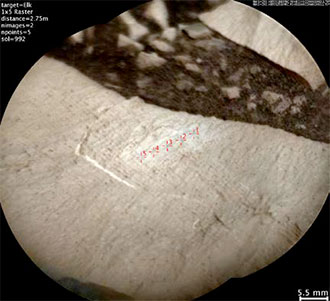
Figure 4. This image from the ChemCam instrument shows detailed texture of a rock target called “Elk” on Mount Sharp, revealing laminations that are present in much of the Murray Formation geological unit of lower Mount Sharp. The locations sampled by the laser are indicated; these revealed the first strong silica enrichments. Based on this analysis , the team sent the rover back to investigate the area further.
Project members briefed the press on the latest rover discoveries, at the American Geophysical Union Conference in San Francisco. Just after the rover climbed a steep rise on the edge of Mount Sharp, the ChemCam instrument team discovered a rock outcrop that was strongly enriched in silica (SiO2) when it sampled a rock named “Elk”. ChemCam observed finely laminated rocks with more than 80 weight % SiO2. A few hundred meters farther along the traverse, Curiosity’s cameras spotted light-toned halos surrounding fractures in the rocks. ChemCam confirmed that these halos consist of enrichments of silica. These halos could be due to acid leaching of the rocks along the fracture, or to deposition of additional silica. The instrument teams are evaluating the data to understand which scenario is more likely. These silica enrichments may stem from two separate events that were well separated in time: 1) perforation of the finely laminated rocks by calcium sulfate veins, or 2) the fracture halos cut across pre-existing calcium-sulfate veins. If the sulfate veins are from a single time period, the fracture halos must have occurred later in time. In addition to the potential similarities to Earth’s early oceans suggested by the finely laminated silica, the fracture halos indicate that significant groundwater activity must have been present substantially later in time than the original deposition of the rock layers. On Earth high silica deposits are often associated with environments that provide support for microbial life. As Curiosity studies successively younger layers up Mount Sharp’s slopes, the mission will investigate how ancient environmental conditions evolved from lakes, rivers and deltas into the harsh aridity of today’s Mars.
Jens Frydenvang (post-doctoral researcher in Space and Remote Sensing, ISR-2 and the University of Copenhagen) presented the ChemCam findings at the American Geophysical Union press briefing. Other ChemCam team members involved in this work at Los Alamos include Roger Wiens, Nina Lanza, and Patrick Gasda (ISR-2); Sam Clegg (Physical Chemistry and Applied Spectroscopy, C-PCS); Steve Johnstone, Dot Delapp, Cindy Little, and Suzi Montano (Space Data Systems, ISR-3). The ChemCam instrument is a joint project between LANL and the Institut pour Recherche en Astrophysique et Planetologie in Toulouse, France.
Reference: “Deposition, Exhumation, and Paleoclimate of an Ancient Lake Deposit, Gale Crater, Mars,” Science 350, (6257) 177 (2015); doi: 10.1126/science.aac7575. Authors: R. C. Wiens (ISR-2) and researchers from California Institute of Technology, Imperial College London, Malin Space Science Systems, University of California-Santa Cruz, and - Berkeley; Indiana University, University of California-Davis, Jet Propulsion Laboratory, Washington University in St. Louis, Smithsonian Institution, University of Tennessee, Johns Hopkins University, Le Centre National de la Recherche, Université de Nantes, Planetary Science Institute, Western Washington University, NASA Ames Research Center, NASA Goddard Research Center, Université de Lyon, Texas A&M University, University of Guelph, Stony Brook University, University of Texas-Austin, NASA Johnson Research Center, Brown University, and the University of New Mexico-Albuquerque.
Roger Wiens leads ChemCam with funding from NASA. The research supports the Lab’s Global Security mission area and the Science of Signatures science pillar through remote sensing for space situational awareness. Technical contact: Roger Wiens
Materials Physics and Applications
Los Alamos leads consortium to enhance fuel cell technology
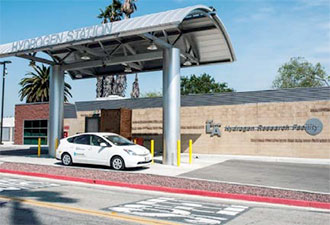
Photo. A fuel cell electric vehicle at a fueling station in California. DOE photo
Commercial use of fuel cells as a clean source of energy in vehicles and stationary power generators is gaining ground. However, further improvements are needed to make widespread commercialization feasible. To advance this zero emissions source, Los Alamos is leading a five-year Fuel Cell Performance and Durability Consortium that aims to overcome cost and durability barriers of polymer electrolyte membrane fuel cells. DOE’s Fuel Cell Technologies Office within the Office of Energy Efficiency and Renewable Energy has committed more than $20 million to the effort this year, with similar levels planned over five years, subject to appropriations.
Polymer electrolyte membrane fuel cells produce electricity through the reaction of hydrogen and oxygen. The only emission is the water formed when the proton and electrons combine with the oxygen. Fuel cell technologies could significantly benefit the nation’s energy security, the environment, and the economy by offering reduced oil consumption and highly reliable grid-support, reduced greenhouse gas emissions and air pollution, as well as expanded renewable power use and highly efficient conversion. These fuel cells are deployed in demonstration vehicles and are beginning limited commercialization. However, they fall short of DOE targets for this technology, which are required for widespread consumer acceptance.
Dimitrios Papageorgopoulos (DOE Fuels Cells program manager) will lead the consortium, Rod Borup (Materials Synthesis and Integrated Devices, MPA-11) will be the director, and Adam Weber (Lawrence Berkeley National Laboratory) will be the deputy director. National lab consortium members are Argonne National Laboratory, Lawrence Berkeley National Laboratory, Los Alamos National Laboratory, the National Renewable Energy Laboratory, and Oak Ridge National Laboratory.
The consortium will coordinate national laboratory activities related to fuel cell performance and durability, provide technical expertise, and integrate activities with industrial developers. Rangachary Mukundan (MPA-11) will use the Laboratory’s wealth of fuel cell expertise and materials characterization tools in his role as thrust coordinator to evaluate the performance and durability of the membrane electrode assembly.
LANL held a kick-off meeting, which brought together researchers from other national laboratories and three officials from the DOE Fuel Cell Technologies Office (Fuel Cells Program Manager Dimitrios Papageorgopoulos, Technology Manager Dave Peterson, and Education and Outreach Project Manager Greg Kleen). The all-day meeting covered topics ranging from strategies for each fuel cell component to plans for reaching out to industry and international partners, and led to solidified statements of work.
Since the 1970s, Los Alamos scientists have made breakthroughs that have contributed to the development of modern fuel cell systems – from a revolutionary technique to build membrane electrode assembles for polymer electrolyte membrane fuel cells to developing advanced materials and modifying operating strategies that reduce degradation. The work supports the Lab’s Energy Security mission area and Materials for the Future science pillar through the development of materials for clean energy sources. Technical contact: Rod Borup
Physics
Experimental platform to study heterogeneous mix in ICF implosions
The goal of the Inertial Confinement Fusion (ICF) program is thermonuclear ignition and burn of a deuterium-tritium (DT) capsule in a laboratory environment. Understanding turbulent mix remains a key obstacle on the path to ignition. As part of this program, a multi-division Los Alamos team has taken a major step in the development of an experimental platform for studying the effect of heterogeneous mix on thermonuclear burn. The researchers imploded a capsule filled with low-density deuterated plastic foam on the National Ignition Facility (NIF) at Lawrence Livermore National Laboratory. Building on work performed at the OMEGA Laser Facility at the University of Rochester, a team led by Melissa Douglas (XTD Integrated Design & Assessment, XTD-IDA) designed, fabricated, and fielded two implosion experiments to determine the feasibility of the concept and reproducibility of the target performance.
Two capsules containing deuterated hydrocarbon foam (CH0.5D0.5) at 40 mg/cm3 were imploded using x-ray drive from NIF hohlraums. Measurements of the neutron yield, x-ray bang time, and symmetry of the implosions were performed. Reproducibility was exceptional, with the yield varying by only 4% from one shot to the next, and the bang times were consistent to within 20 ps. Yields were 70% of pre-shot calculations, and the bang times were predicted to within 50 ps of measured values.

Figure 5. Foam-filled capsules were imploded using x-ray drive from a NIF hohlraum (left). Measured implosion symmetry (lower right) matched predictions (upper right), as did bang time.
Mix of ablator material into the fuel of an inertial confinement fusion capsule introduces non-burning material, diluting the fuel and reducing the burn. The amount of the reduction is dependent in part on the morphology of the mix. Uniform mix produces the greatest dilution, while heterogeneous (or “chunky”) mix can have regions of higher fuel concentration that allow more burn to occur.
A probability distribution function (PDF) burn model approach has been developed to estimate the burn rate in unresolved but mixed material computational cells. This model utilizes the average concentration of mixed materials and the variance in this quantity across computational cells, which are provided by the BHR turbulent transport mode. The result is a prescription for the concentration (i.e., morphology) of fuel and ablator material in a cell.
The team is developing the MARBLE ICF platform for use on NIF to test the probability distribution function burn model. This platform consists of a capsule filled with deuterated plastic foam at a density of a few tens of milligrams per cubic centimeter, with tritium gas filling the voids in the foam. X-rays from a laser-driven hohlraum will drive the capsule, and the resulting shocks will induce turbulence that will result in the mixing of deuterium from the foam with the tritium gas.
The neutron yield will measure capsule performance. Fusion neutrons are produced from two reactions. The fusion of two deuterium nuclei in the foam produces 2.5 MeV neutrons. Because the foam makes up more than 95% of the mass inside the capsule, the yield of these DD neutrons is insensitive to the degree of mix. Fusion of the deuterium nuclei with tritium nuclei in the gas produces 14 MeV neutrons. Because the foam and gas must mix to produce these 14 MeV neutrons, the DT neutron yield is proportional to the degree of mixing. The ratio of DT to DD neutrons is a sensitive indicator of the degree of mix. This ratio will be compared to predictions from a variation of the probability distribution function burn model that quantifies reaction rates from initially separated reactants.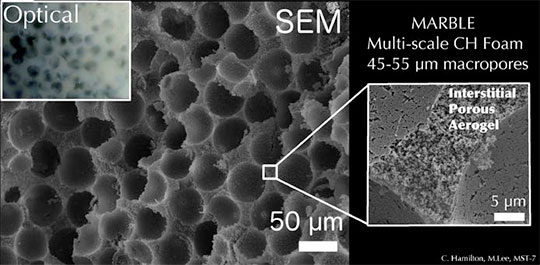
Figure 6. Engineered foam with prescribed voids that will be used to control the homogeneity of mix in future experiments to test the PDF burn model.
The team will perform experiments using foam with voids of varying size to create and control the heterogeneity of the mix. Small voids are expected to mix with the plastic, approximating uniform mix and producing the greatest DT/DD yield ratio. The mix will remain incomplete for the largest voids, and the ratio will be reduced. Researchers will conduct foam development work at Materials Science and Technology (MST) Division’s Target Fabrication Facility.
Initial experiments have demonstrated that the use of low-density foam in ICF capsules is feasible and that current simulation techniques accurately predict implosion behavior. Accurate and reproducible yields and bang times facilitate design of the more complex targets needed to begin the heterogeneous mix experiments.
Melissa Douglas (XTD-IDA) leads the MARBLE team, which includes experiment [T. Murphy, R. Shah, and J. Cobble (Plasma Physics, P-24)], simulation [R. Olson and I. Tregillis (Plasma Theory and Applications, XCP-6); B. Haines (Eulerian Codes, XCP-2); J. Smidt and J. Fincke (XTD-IDA)], and target fabrication [J. Oertel, C. Hamilton, M. Lee, B. Randolph, and D. Schmidt (Engineered Materials, MST-7)]. NNSA funded this work through the Inertial Confinement Fusion Program and the Science Campaigns. The research supports the Lab’s Nuclear Deterrence and Energy Security mission areas, and the Nuclear and Particle Futures science pillar, with a focus on the High Energy Density Plasma and Fluids thrust area. Technical contacts: Melissa Douglas and Thomas Murphy
Proposal Call
Call for Proton Radiography proposals

The Los Alamos Neutron Science Center (LANSCE) has issued a proposal call for experiments using the Proton Radiography Facility (pRad) during fiscal year 2017. The proposal deadline is 5 PM (MST) on March 15, 2016. Link to the Proton Radiography proposal call: lansce.lanl.gov/uresources/proposals.shtml.
The Proton Radiography facility uses 800-MeV protons, provided by the Lab’s LANSCE accelerator facility, to diagnose dynamic and static experiments in support of national and international weapons science and stockpile stewardship programs and other research that benefits from the unique capabilities of proton radiography. Proton radiography capability overview: lansce.lanl.gov/prad
Users are strongly encouraged to work with the pRad team when developing proposals. Contact Alexander (Andy) Saunders ([email protected]) for technical questions regarding details involved in fielding pRad experiments. Direct other questions to the pRad user office ([email protected]).
NNSA programmatic sponsors fund pRad beam production operations. However, approximately 10% of the beam time at pRad is available for compelling scientific proposals from institutions without programmatic sponsors and proprietary work or work-for-others agreements. The user bears costs for personnel not on the pRad team and unique experimental costs, including fabrication and assembly of the experimental package.
Proposals from any U.S. Government funded submitters must be reviewed by the appropriate classification authority and be appropriately marked prior to submittal. Submit unclassified proposals or unclassified versions of classified proposals to the LANSCE proposal submission website: www.lanl.gov/orgs/lansce/
Classified proposals must have classification levels appropriately determined and be appropriately marked. Contact Alexine Salazar ([email protected]) to request a classified template. Classified versions or attachments of proposals must be sent to Salazar either electronically on the secure network ([email protected]) or via appropriate classified mail transmission channels. If the latter is chosen, contact Salazar first to ensure that proper mailing protocols are followed. For proposals containing sigma 15 or 20 information, contact Frans Trouw ([email protected]) for information on how to proceed
The Program Advisory Committee (PAC) will review all proposals. The committee is an advisory committee to the LANSCE User Facility Director. The PAC ranking may be folded into programmatic sponsor’s decision-making processes and used as a means for Laboratory management to identify potential funding. Submitted proposals will be ranked on: 1) programmatic relevance and impact, 2) quality of the science being proposed, 3) quality of experiment conception and feasibility with the stated resources and requested time, and 4) existence of the physical foundations for the proposed research. Technical contact: Anna Llobet Megias
Scientific Society Meetings
American Society for Quality

The 59th Annual Fall Technical Conference, co-sponsored by the Chemical & Process Industries Division and the Statistics Division of the American Society for Quality (ASQ) and the American Statistical Association (ASA), took place in Houston, Texas. The conference is the premier forum for researchers and practitioners to discuss the more effective use of statistical methods for research, innovation, and quality improvement. Two Statistical Sciences (CCS-6) researchers gave talks.
Joanne Wendelberger (CCS-6 Group Leader), presented “Statistical Issues and Methods in Metrology,” in the ASQ Statistics Division Invited Session on Metrology and Measurement Issues. She based the talk on concepts developed in the paper, “An Introduction to Statistical Issues and Methods in Metrology for Physical Science and Engineering,” which appeared in the Journal of Quality Technology. Michael Hamada and Leslie Moore (CCS-6), Tom Burr (Nuclear Nonproliferation and Security, GS-NSS), Stephen Vardeman, Max Morris, and Huaiqing Wu (Iowa State University); and J. Marcus Jobe (Miami University) coauthored the paper. The researchers collaboratively developed the statistics and metrology concepts over a period of several years while working on a variety of problems involving measurement processes for material aging and other physical systems. Wendelberger is a Fellow of the ASA and was elected to serve on the ASA Council of Sections to represent the Section on Physical and Engineering Sciences.
Christine Anderson-Cook (Project Leader for Complex System Health Assessment) presented “Understanding and Incorporating Uncertainty into Multiple Response Optimization.” Her talk illustrated methods to examine the best combination of factors based on different prioritizations of the responses using the Pareto front approach. She reported that using graphical summaries to visualize the trade-offs between alternatives could help facilitate a discussion about priorities and what are promising solutions. Anderson-Cook described strategies for incorporating the uncertainty associated with the estimated response surfaces for each response and provided several examples of how the methods scale when the number of responses and/or the dimensionality of the factor space increases. This work is part of the Complex System Health Assessment project, which develops statistically-based tools to improve the quality of reliability assessment using multiple sources of data and facilitates improved management of conventional munition stockpiles through individualized monitoring and management of assets. Anderson-Cook is a Fellow of ASA and ASQ.
During the conference Anderson-Cook received the prestigious ASQ Chemical and Process Industries Division Shewell Award for best paper. Her paper, “Selecting a Best Two Level 16-Run Screening Design from the Catalog of Non-Isomorphic Regular and Non-Regular Designs for Six to Eight Factor,” examined how to select an ideal set of observations to collect as part of a designed experiment that optimizes several aspects of the goodness of the design. She is the only two-time winner of this award. Technical contacts: Joanne Wendelberger and Christine Anderson-Cook
Acoustical Society of America
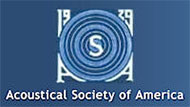

Figure 7. Schematic shows characterization of defects with nonlinear acoustics.
The meeting of the Acoustical Society of America (ASA) in Jacksonville, Florida featured research from the Elasticity, Vibrations and Acoustics Laboratory in the Geophysics Group (EES-17). Pierre-Yves Le Bas, T. J. Ulrich, and Marcel Remillieux (EES-17) gave invited presentations.
The ASA online pressroom featured a layman article reporting on the paper “Time Reversal Elasticity Nonlinear Diagnostic method for Crack Detection and Depth Estimation,” which Le Bas presented in the Nonlinear Nondestructive Evaluation session. Detecting early stage damage (e.g. a crack or other defect) before it becomes structurally dangerous is a challenging problem with great economic importance. Nonlinear acoustics is a method that is extremely sensitive to tiny cracks. For example, upon striking a bell, a discordant result indicates that the bell is cracked. The tones produced by striking an object enable a determination of whether or not the object is damaged.
The time reversal method of crack detection works by localizing vibration in a known direction. A sample can be made to vibrate either perpendicular or parallel to the surface of an object. Time reversal focuses energy at defined locations in a sample to characterize crack presence and orientation. To fully characterize a sample, three scans are made in three orthogonal directions. Scanning in three different orientations recreates the orientation of a crack, and scans at different frequencies provide information on the depth profile of a crack. The higher the frequency, the smaller the spot size, i.e., the area of the focused energy. However, the extent of the focus is also the depth that this technique can probe. Lower frequency enables a deeper investigation and a more complete characterization of the sample. Thus, the time reversal method can enable characterization of a crack, its orientation, and depth profile. This characterization ability is currently only available using techniques, like x-ray CT, which are not as easily deployable as ultrasonic ones.
In addition to Le Bas, co-authors include: Brian Anderson (EES-17 and Brigham Young University), Marcel Remillieux and T. J. Ulrich (EES-17), and Lukasz Pieczonka (AGH University of Science and Technology, Poland). The DOE Nuclear Energy Used Fuel Disposition Program and Laboratory Directed Research and Development (LDRD) funded different aspects of the work, which supports the Lab’s Energy Security mission area and the Information Science and Technology and Science of Signatures science pillars. Link to the ASA online pressroom article: http://tinyurl.com/pjdfrca Technical contact: Pierre-Yves Le Bas
Advanced Bioeconomy Leadership Conference
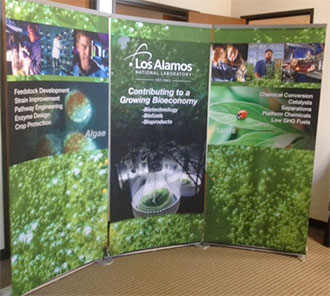
Photo. Booth banner at the conference focuses on LANL research.
Los Alamos was among eight national laboratories showcasing bioenergy technologies at the Advanced Bioeconomy Leadership Conference (ABLC) in San Francisco, California. ABLC focused on advanced low carbon fuels, chemicals, and materials, advanced foods, seed and trait development, crop and soil technology, drones and robotics, and waste mitigation. Experts and stakeholders from every stage of development and deployment of advanced biofuels and bioproducts attended the conference.
Babs Marrone (Bioscience, B-DO), Richard Sayre (Bioenergy and Biome Sciences, B-11), and Miranda Intrator (Feynman Center for Innovation, FCI) set up a booth at the conference, which included brochures and magazines describing LANL’s capabilities in bioenergy technologies such as algae growth, fuel production, sequencing, and chemical conversion. Marrone gave a webinar prior to the conference and a talk during the conference about Los Alamos programs to improve bioenergy. She reviewed highlights from the current DOE-funded bioenergy technologies R&D portfolio at the Lab and the National Alliance for Advanced Biofuels and Bioproducts (NAABB) program, which recently came to a close. Marrone also described the new Producing Algae for Coproducts and Energy (PACE) consortium, a collaboration with the Colorado School of Mines, industry, and academia. Sayre is the science lead for PACE, which aims to take algae and fuel technologies developed in NAABB to the next step towards widespread production. The team plans to enhance overall algal biofuels sustainability by maximizing carbon dioxide, nutrient, and water recovery and recycling, as well as bio-power co-generation. The DOE Office of Energy Efficiency and Renewable Energy funded the NAABB and PACE projects, which support the Lab’s Energy Security mission area and the Science of Signatures and Materials for the Future science pillars. Technical contact: Babs Marrone
American Physical Society, Division of Plasma Physics
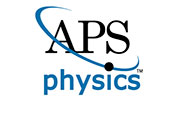
From organizing the scientific program to presenting papers and chairing sessions, Los Alamos scientists demonstrated scientific leadership in the American Physical Society’s (APS) Division of Plasma Physics meeting in Savannah, Georgia.
Los Alamos Physics (P) Division Leader David Meyerhofer organized the meeting in his role as the Division’s chair elect and Scientific Program Committee chair. At the end of the meeting, he became chair of the Division of Plasma Physics and will be responsible for its governance. Leslie Sherrill (Primary Physics, XTD-PRI) served on the Scientific Program Committee, and John Kline (Plasma Physics, P-24) was elected to serve three years on the Executive Committee.
Los Alamos staff chaired the following sessions:
- John Kline (P-24), Inertial Confinement Fusion
- Blas Uberuaga (Materials Science in Radiation and Dynamics Extremes, MST-8), Measuring and Modeling of Plasma Material Interactions
- Paul Bradley (Plasma Theory and Applications, XCP-6), Hydrodynamic Instability
- Hui Li (Nuclear and Particle Physics, Astrophysics and Cosmology, T-2), Plasma Energization-interactions between Fluid and Kinetic Scales
- Leslie Welser Sherrill (XTD-PRI), Baryonic Mix and Neutron Diagnostics
- Gian Luca Delzanno (Applied Mathematics and Plasma Physics, T-5), Computer Simulation Methods
Elizabeth Merritt and Kirk Flippo (P-24) judged the undergraduate poster sessions. Technical contact: Steve Batha










